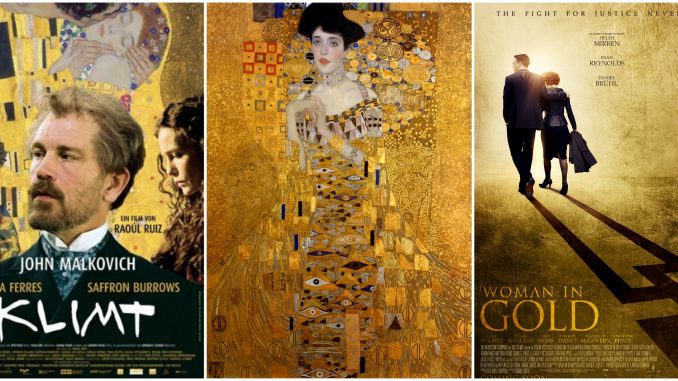
Gustav Klimt’s art is thoroughly fin de siècle. It expresses both the bourgeois liberalism of Viennese society at the turn of the century and served as a harbinger of the apocalyptic catastrophe that would befall Austro-German society during the two World Wars. It cannot be denied however, that Klimt was and still is probably the most sublime of all the erotic painters of his time.
In the last decade, Hollywood has foisted upon the unsuspecting public two very different types of film that revolve around Klimt and his paintings.
The first was Raoul Ruiz’s 2006 impressionistic biopic Klimt starring John Malkovich as the moody, arrogant, and syphilis-ridden libertine. The film itself is undoubtedly arthouse and the disjointed plot plods along ponderously. However, what cannot be denied is the exquisite visuals and lavish sets. It gives the viewer the distinct impression of being in a Klimt painting. Admirers of Klimt will find this movie elegant, enigmatic, and erotic.
Ruiz’s film portrays Gustave Klimt as a freethinking, free-living artist who turned to women for their sensuality and drew out of them in terms of lust, pain, life, and death. With its ancient themes, primeval myths, and obscure metaphors, the film is a treat for the eye and for the mind – but a full appreciation of the film requires the patience of a seasoned arthouse viewer.
The Baroque Palace Belvedere in Vienna hosts an impressive collection of Klimts. The most majestic of all is of course, “The Kiss”. Conspicuously absent, however, from the collection is the exquisite portrait of Adele Bloch-Bauer. That’s because the painting was sold for US$135 million to Ronald Lauder for the Neue Galerie in New York City.
How this came to be is depicted in Simon Curtis’ 2015 film Woman in Gold starring Helen Mirren and Ryan Reynolds. The film follows Maria Altman, niece of Adele Block-Bauer, as she takes on the Austrian government to recover the Klimt painting she believes rightfully belongs to her family.
The film is touching, uplifting, dramatic, and emotive. Helen Mirren gives a flawless performance as an octogenarian Jewish refugee who has created a new life for herself in America after fleeing Nazi persecution in Vienna. Ultimately, the film is about the triumph of justice and the righting of a historic wrong. To see an old woman sue the Govt. of Austria in the U.S. Supreme Court is in itself reason enough to watch the film. What the film teaches us about history, bureaucracy, treachery, cruelty, and the indomitable nature of the human spirit is added incentive to appreciate this film.
Behind all the bureaucracy and legal chicanery lies the painting of Adele Block-Bauer in all its stunning glory and irresistible sensuality. The art historian Sophie Lillie points out that its intricate ornamentation and exotic motifs heralded the dawn of Modernity and a culture radically forging a new identity. With this painting, Klimt created a secular icon – a Mona Lisa of Austria – that would come to represent that aspirations, hopes, and dreams of an entire generation Viennese.
Ultimately, though both films are very different in their style, content, and delivery, what shines through is the genius of Klimt. As the critic Gottfried Fliedl points out, Klimt offers us the utopian realm of an autonomous, natural eroticism – a regressive fantasy world. The never-ending fascination of Klimt’s art is on full display in Vienna. Klimt is on ceramic mugs, umbrellas, shop windows, posters, postcards, and public buses. For lovers of art and the female form, the eroticism of Klimt’s work and his ability to unfetter art from morality is timeless and enduring. In their own way each of these two films celebrates the wonder, majesty, and sensuality that is Klimt.